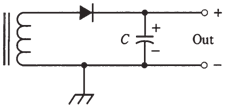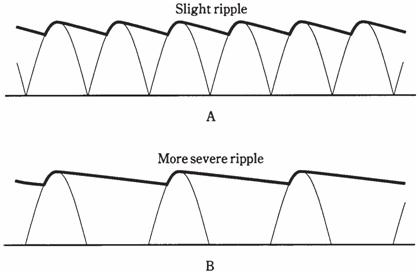Filter:
Electronic equipment does not like the pulsating direct current which comes straight from a rectifier. The ripple in waveform should be smoothed out, so that pure battery like direct current is supplied. The filter performs this.
Capacitors alone
The simplest filter is large value capacitors, which is connected in parallel with the rectifier output. Electrolytic capacitors are almost used all the time. They are polarized; they should be hooked up in right direction. Typical values range in hundreds or thousands of microfarads.

Figure- A simple filter. The capacitor, C, should have a large capacitance.
The more current drawn, more capacitance is required for good filtering. This is because load resistance decreases as current increases. The lower the load resistance, faster the filter capacitors will discharge. Larger capacitances hold charge for the longer time with the given load.
Filter capacitors work by trying to keep the direct current voltage at its peak level. This is easier to do with output of a full wave rectifier as compared with the half-wave circuit. The remaining waveform bumps are ripple. With a 1/2-wave rectifier, this ripple has same frequency as the alternating current, or 60 Hz. With a full wave supply, ripple is 120 Hz. The capacitor gets recharged twice with a full wave rectifier, as compared with a 1/2-wave rectifier. This is why the ripple is less severe, for the given capacitance, with the full wave circuits.

Figure--Filtered output for full wave rectification (A) and the half-wave rectification (B).